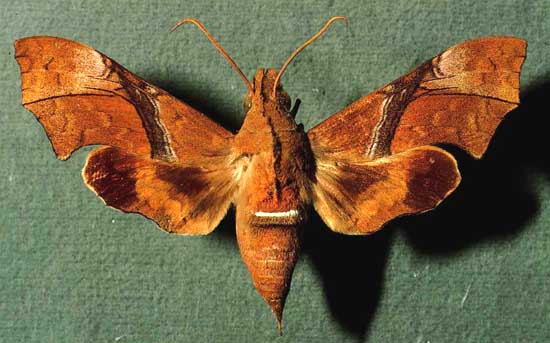
Aleuron iphis male courtesy of Dan Janzen.
This site has been created by Bill Oehlke.
Comments, suggestions and/or additional information are welcomed by Bill.
TAXONOMY:
Family: Sphingidae, Latreille, 1802 |
|
|
Updated as per http://biological-diversity.info/sphingidae.htm (Belize), November 2007 Updated as per Fauna Entomologica De Nicarauga, November 2007 Updated as per The Known Sphingidae of Costa Rica, November 2007 Updated as per personal communication with Jose Monzon (Guatemala); May 2009 Updated as per AN ANNOTATED CHECKLIST OF THE SPHINGIDAE OF BOLIVIA, December, 2009 Updated as per Sphingidae (Lepidoptera) de Venezuela, Compilado por: Maria Esperanza Chacon; December 2009 Updated as per CATE (description; Mexico, Guyana, Peru, Brazil) February 18, 2011 Updated as per "A Hawk Moths fauna of southern Maranhao state, Brazil, ... "; NEVA: Jahrgang 34 Heft 3 November 2013; via Jean Haxaire; April 5, 2014 Updated as per personal communication with Sergio D. Rios Diaz in CAT�LOGO DE LOS SPHINGIDAE (INSECTA: LEPIDOPTERA) DEPOSITADOS EN EL MUSEO NACIONAL DE HISTORIA NATURAL DEL PARAGUAY; sent to me in July 2014 by Sergio D. Rios Diaz. Updated as per personal communication with Ezequiel Bustos (Shilap revta. lepid. 43 (172) diciembre, 2015, 615-631 eISSN 2340-4078 ISSN 0300-5267), January 4, 2016 Updated as per personal communication with Francierlem Oliveira (Extremoz, Rio Grande do Norte, Brazil, July 9, 2017), May 17, 2018 Updated as per Hawk-moths (Lepidoptera: Sphingidae) of Trinidad, West Indies: an illustrated and annotated list; Matthew J.W. Cock; March 31, 2022 |

This site has been created by Bill Oehlke.
Comments, suggestions and/or additional information are welcomed by Bill.
TAXONOMY:
Family: Sphingidae, Latreille, 1802 |

Aleuron iphis, Extremoz, Rio Grande do Norte, Brazil,
July 9, 2017, courtesy of Francierlem Oliveira.
Upperside of abdomen with a conspicuous basal white belt, the following tergites brownish. Palps slightly angulated laterally. Forewing upperside crossed medially by four back lines, the basalmost bordered with white basally and distally. Forewing underside with a brown median patch that is contiguous with the discal cell between M1 and CuA1 and extends basad posteriorly. CATE
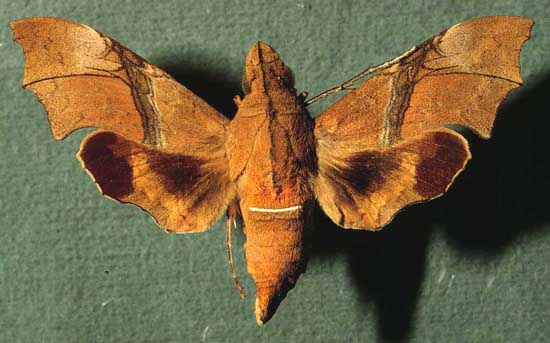
Larvae feed on Tetracera volubilis, and Curatella americana, and probably other members of Dilleniaceae family.In the early instars, this species has a long tail and a white belt. | 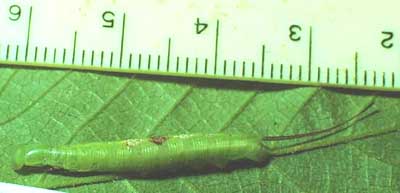
|
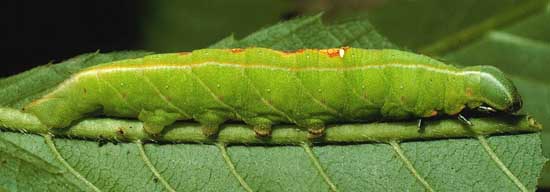
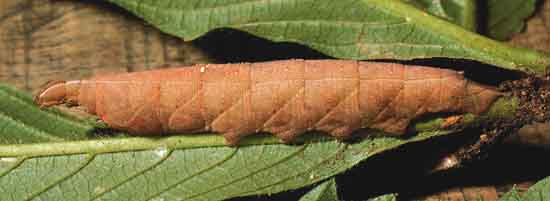
Caterpillars pupate in underground chambers. Pupae are smooth and shiny, and attractively "marked." Pupal stage is usually about 18 days except for diapause during dry season. | 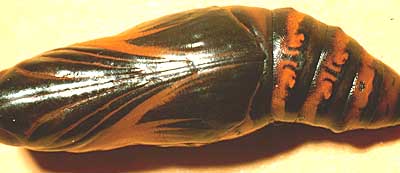
|
Use your browser "Back" button to return to the previous page.
This page is brought to you by Bill Oehlke and the WLSS. Pages are on space rented from Bizland. If you would like to become a "Patron of the Sphingidae Site", contact Bill.
Please send sightings/images to Bill. I will do my best to respond to requests for identification help.
Enjoy one of nature's wonderments: Live Saturniidae (Giant Silkmoth) cocoons.
 Show appreciation for this site by clicking on flashing butterfly to the left. The link will take you to a page with links to many insect sites. |